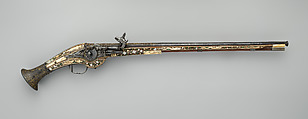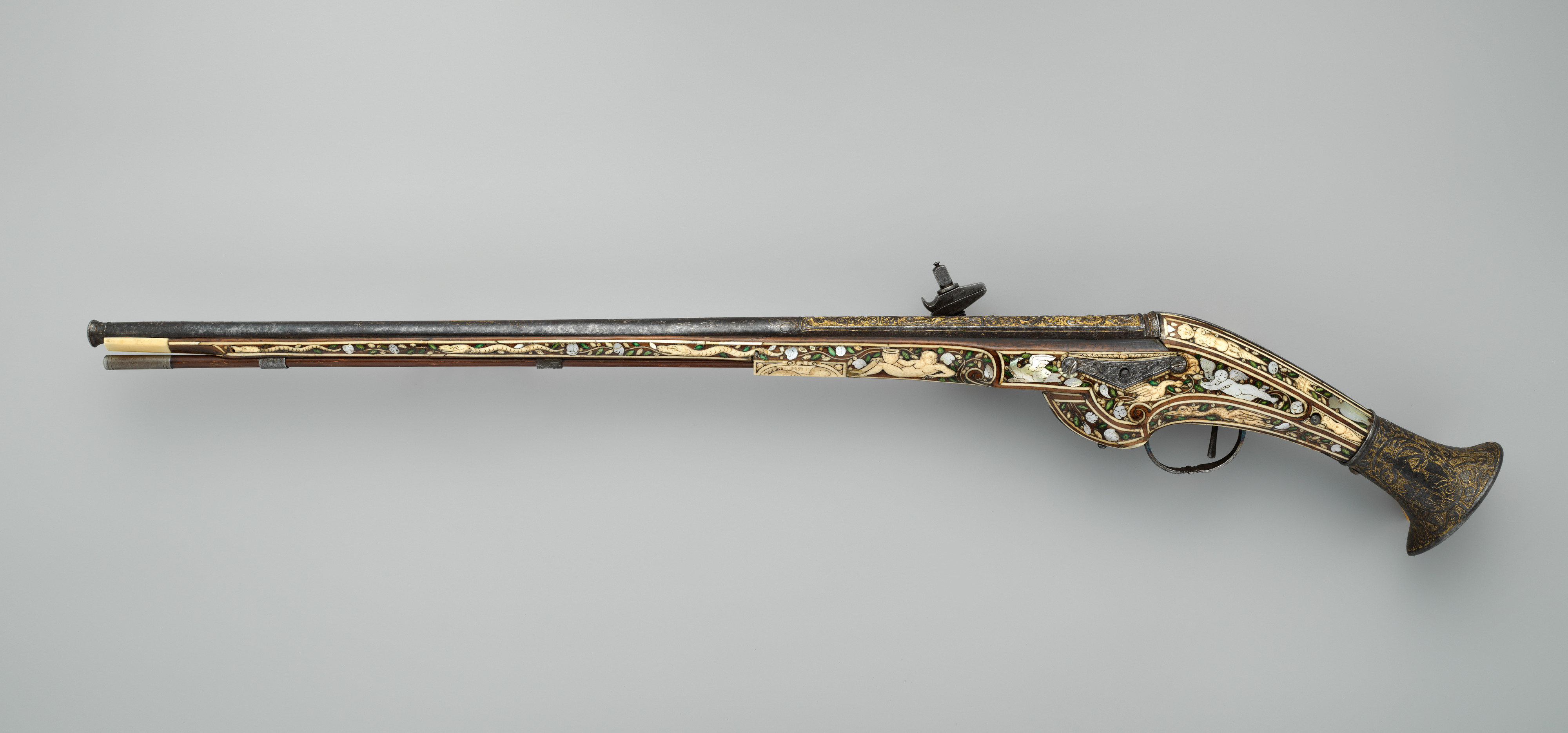Wheellock Pistol
Not on view
With their elegant form, innovative use of materials, and imaginative ornament, French firearms were trend-setters throughout Europe from the early seventeenth to mid-nineteenth century. French influence in firearms design was spread in several ways: by the lavish gifting of firearms as part of French diplomatic practice; the publication in Paris of numerous engraved pattern books of firearms ornament; and the wide dispersal of Huguenot (Protestant) gunmakers after the revocation of the Edict of Nantes in 1683. The rise of French gunmaking to its pre-eminent position did not happen overnight, however, but had its origins in the sixteenth century. This whellock pistol, a rare example of high quality French gunmaking before 1600, epitomizes this early, innovative stage.
The pistol’s long, slender lines, small-caliber barrel, and distinctive wheellock mechanism are characteristic French features. So too is the elegant and sophisticated decoration. The barrel is chiseled in low relief at the breech end with strapwork, foliage, and a terme, the ornament gilt overall. Forward of this section, the smooth surface is engraved with emblems that include the fleur-de-lis, a flaming heart, an arrow entwined by a serpent that were gilt on a heat-blued ground, the colors now faded. The lockplate is worked in relief at its rear point with the head of a fierce dog with bared teeth, the head of the cock is fashioned as a horse’s head, and the wheel is fitted with a guide in the form of a siren. The wood stock is densely inlaid with shaped and engraved pieces of white staghorn, some stained green, and mother-of-pearl formed as dragons, putti, and grotesques, a type of embellishment that reflects—more in the choice of materials than style—the influence of contemporary German firearms. The pistol’s metal buttcap of ‘fishtail’ shape that is quite different from the spherical or ovoid butt common to most European pistols of the period. On this example, the buttcap is of copper alloy, the sides chiseled and engraved with an armed nude putto on one side and the helmeted head of a hero on the other, with, on the flat end, an embossed mask of a draped female head of Fontainebleau inspiration, the whole formerly gilt overall. A mere half-dozen French wheellock pistols are recorded with these distinctive metal butts, including another in The Met’s collection (acc. no. 14.25.1431), but it is unclear if they originated in the same workshop.
Highly decorated weapons were usually made for men of wealth and status, but few are sufficiently marked as to provide evidence of the maker, date of manufacture, and identity of the original owner. Collectors often fill in these gaps with hopeful attributions and associations that, upon close inspection are not justified. This pistol was formerly thought to have been made in the workshop of the famous Le Bourgeois family of gunmakers active in Lisieux, in Normandy, in the late sixteenth or early seventeenth century for King Henry IV of France (r. 1590–1610). Unfortunately, the maker’s mark struck on the lockplate is partly defaced and, while it includes the letter B, does not conform to any of the recorded marks used by the brothers Le Bourgeois. Similarly, while the barrel decoration includes a French fleur-de-lis and the buttplate bears a decorative motif that was once interpreted to be the letter H, there are no obvious reasons to associate the pistol with the Bourbon monarch. The unusual emblems on the barrel were undoubtedly of some personal importance to the owner, but emblems in that period were often purposely enigmatic. They continue to retain their secret.
Due to rights restrictions, this image cannot be enlarged, viewed at full screen, or downloaded.
This artwork is meant to be viewed from right to left. Scroll left to view more.



